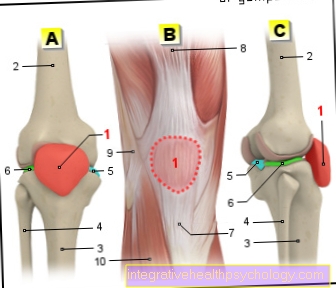Operation of the spinal stenosis
Operative therapy
Surgical therapy is reserved for very severe cases of spinal stenosis. The reason for an operation can be:
- Unbearable pain that cannot be managed conservatively
- Neurological failure symptoms
- Disability / inability to walk
- Circumscribed spinal stenosis
- Young patient age

What surgical procedures are there for this?
The treatment of choice for localized spinal stenosis would be open microsurgical decompression.
Microsurgery is an open operation with a very small skin incision, the use of a surgical microscope and the use of special, angled instruments.
Under microscopic magnification, those parts that are responsible for the spinal canal stenosis / nerve root stenosis are removed, i.e. decompressed (Vertebral arch parts, ligamentum flavum parts, vertebral joint parts). The surgical trauma is limited to the bare minimum.
Read more on the topic: Therapy of spinal stenosis
Advantages of the microsurgical approach in the operation of spinal stenosis are:
- Small surgical trauma, resulting in less blood loss and less scarring.
- Possibility of early mobilization and rehabilitation.
- Less nerve and vascular injuries.
- Preservation of stability in the movement segment
In the case of a long spinal stenosis over several vertebral levels, the incision must be widened, corresponding to an open operation. The surgical microscope is then used again for individual decompression steps.
Exists at the same time as Spinal stenosis If there is a pronounced instability of the vertebral body, the unstable levels of the vertebral column must also be stabilized during the operation.
This can be done in different ways; a two-stage operation with an operation from the front and one from the rear may be necessary (abdominal and backward). Sometimes a single operation from behind is sufficient. The end result is a stiffening of the Spine (Spinal fusion).
Surgery with or without stiffening?
It cannot be said in general whether a spinal stenosis operation with or without stiffening is better. The advantage of a stiffening is that this increases the stability of the affected spinal column segment and thus, if necessary, the spinal canal can also be better stopped.
However, this happens at the expense of mobility, which is usually better without stiffening. In addition, the stiffening can cause discomfort such as pain in the long term. Therefore, as far as possible, no reinforcement is used.However, if there is a risk of bone instability, stiffening may be inevitable.
Risks and Complications of Open Surgery
Surgery for spinal stenosis is associated with many risks and occasionally complications. For this reason, surgery is usually the last possible therapy if all non-surgical measures have not led to sufficient success.
If the procedure is performed as an open operation on the back, general anesthesia is required. This alone already harbors risks and is a burden for the body. Especially with old people there is a risk that complications can arise. However, since older people in particular are affected by severe spinal stenosis for which an operation is being considered, it is often necessary to weigh up whether general anesthesia is possible or the risks are too great. Complications of anesthesia can include cardiovascular disorders, as well as nausea and Vomit be after the operation.
Further risks arise from the procedure itself: As with any operation, complications can result in bleeding or secondary bleeding as well as damage to structures such as nerves or vessels. There is also the risk of inflammation of the surgical site or the wound. Scars can also remain. One possible complication that can occur especially during surgery on the spine is damage to nerve roots. As a result, the symptoms of spinal canal stenosis can worsen or, in the worst case, even paraplegia.
Another risk of spinal stenosis surgery is an injury to the skin of the spinal cord (meninx spinalis). This must be sewn, otherwise there is a risk of inflammation that can spread to the meninges and the brain itself.
Further complications of the procedure are possible if the surgeon has to operate on large parts of the spine in order to widen the spinal canal. At the expense of relieving pressure on the spinal cord, the spine can become unstable if too much bone is removed. This risk is particularly increased in the elderly. because these already often show signs of wear and tear and therefore a reduced stability of the spine anyway.
Read more on the topic: Risks of general anesthesia
Risks and complications of minimally invasive surgery
A good alternative to open surgery with fewer risks and complications is a minimally invasive procedure for treating spinal stenosis. Local anesthesia is sufficient instead of general anesthesia. However, such an intervention also carries risks.
As a complication, permanent nerve damage can also occur. Wound healing disorders, inflammation or excessive scarring are much less common than with open spinal stenosis surgery, but they also occur.
Read more on the topic: Side effects of local anesthesia
Pain after the operation
As after any operation, pain occurs first after an intervention to correct spinal stenosis. However, these are already treated preventively through the use of painkillers. If pain does occur, the doctor should be informed so that he can increase the dosage or switch to a more effective preparation.
In the course of the hospital stay, the pain should subside and the pain medication should be slowly withdrawn. If a spinal canal stenosis operation is successful, the previous possible pain will be relieved over the long term. However, such an optimal result is not achieved in every case.
Often there is only a slight or at least incomplete reduction in pain after the operation. In some cases the symptoms remain unchanged. In the worst case, it can even happen that the pain after the operation is even worse than before the operation.
Duration of the operation
The duration of the operation is on average between 60 and 90 minutes from the first skin incision to the last suture. The duration can also be shorter for very experienced surgeons. However, if complications arise or the anatomical conditions are particularly difficult, the procedure can take significantly longer.
You have to add the time before the operation, i.e. getting into the operating room and preparing and performing the anesthesia, which normally takes about 15 minutes. After the operation, the anesthesia will be removed and you will be taken to a recovery room. All you have to do is lie on your back for about four to five hours after the procedure.
Length of hospital stay
The expected length of hospital stay for spinal stenosis surgery is between seven and ten days. On the evening of the day of the operation, you can usually get up and go to the toilet for the first time accompanied by a carer or a nurse. The rest of the day, however, should be spent lying down, including eating dinner. However, this phase of restricted mobility usually only lasts for the day of the operation itself.
As early as the first day after the procedure, you begin to move as normally as possible and should get up regularly and walk short distances at the beginning. These movements and walking distances should be gradually increased over the duration of the hospital stay. Discharge is possible when you are resilient enough to be able to take care of yourself at home or at least be transferred to an inpatient rehab facility.
Length of incapacity for work
The duration of the incapacity for work during a spinal stenosis operation can vary greatly from person to person and depends on various factors. The doctor therefore decides on the length of the certified inability to work in consultation with the patient. This depends essentially on the occupation practiced by the patient.
In an office job, for example, you will be unable to work for less than if you are engaged in heavy physical activity. It is important to follow the doctor's instructions so that the healing proceeds as well as possible and the ability to work can be restored as soon as possible. On average, a spinal stenosis operation can result in an inability to work of four to six weeks. In addition, it must be noted that you must not lift more than ten to 15 kilograms in the first three months after the operation.
Follow-up treatment and rehab
Follow-up treatment after a spinal stenosis operation begins during the hospital stay. In the days after the operation, physiotherapy is performed under supervision so that the patient can be mobilized again as soon as possible. After discharge from the hospital, there are various ways in which further follow-up treatment is made possible.
On the one hand, inpatient rehabilitation can take place. The patient is placed in a rehabilitation clinic for another three to four weeks. This option is particularly suitable for patients who cannot safely take care of themselves after they are discharged from the hospital.
Outpatient rehabilitation is an option for fitter patients. This means that you are released home and regularly go to a rehab center to do exercises.
In the case of patients who are already very mobile again after discharge from the hospital and have only minor restrictions, rehab may be dispensed with and only physiotherapy can be prescribed instead. This usually takes place twice a week for three weeks.
Duration of the entire treatment
The duration of the entire treatment depends initially on how quickly the spinal stenosis is diagnosed, when the indication for surgery is made and how quickly you can get an appointment for the operation. Admission to the hospital usually takes place one day before the operation. Before this, there are usually appointments for preliminary discussions. The procedure takes about 60 to 90 minutes and you can usually be discharged after a week at the earliest.
The subsequent phase of professionally performed rehabilitation or physiotherapy usually lasts between three and six weeks, depending on how mobile and independent the patient is after the procedure. A full load capacity can be expected after about three months at the earliest. After completion of the follow-up treatment, there is usually a final appointment with the treating doctor.





























